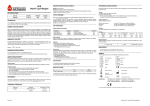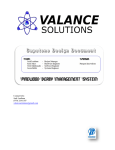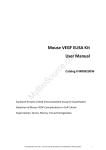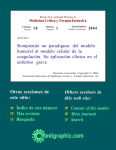Download Human Tissue Factor Activity Kit
Transcript
AssaySense Human Tissue Factor Chromogenic Activity Kit Assaypro LLC 3400 Harry S Truman Blvd St. Charles, MO 63301 T (636) 447-9175 F (636) 395-7419 www.assaypro.com For any questions regarding troubleshooting or performing the assay, please contact our support team at [email protected]. Thank you for choosing Assaypro. Assay Summary Step 1. Add 70 µl AssayMix and add 10 µl of Standard/ Sample per well. Incubate at 37°C for 30 minutes. Step 2. Add 20 µl of Factor Xa Substrate per well. Step 3. Read the absorbance at 405 nm at zero minutes. Read at 405 nm every 5 minutes for 25 minutes. Symbol Key Consult instructions for use H G F E D C B A 1 2 3 4 5 6 7 8 9 10 11 12 Assay Template Human Tissue Factor (TF) Chromogenic Activity Kit (Two Steps, Lipoprotein) Catalog No. CT1002b Sample insert for reference use only Introduction The transmembrane protein tissue factor (TF) is the physiologic trigger of coagulation in normal hemostasis. TF binds and allosterically activates factor VII (FVII). The TF-FVIIa complex cleaves factor IX and X, leading to thrombin generation (1). TF markedly enhances the ability of FVIIa to cleave both macromolecule and small peptidyl substrates (2, 3). Inducible expression of TF in a variety of pathological conditions, including gram-negative sepsis and acute coronary syndromes, is associated with thrombosis (4, 5). TF also plays important roles in vasculogenesis, metastasis, and angiogenesis (6-8). Principle of Assay The AssaySense Human Tissue Factor Chromogenic Activity Kit is developed to determine human TF chromogenic activity in plasma, serum, urine, tissue, and cell culture samples. The assay measures the ability of lipoprotein TF/FVIIa to activate factor X (FX) to factor Xa. The amidolytic activity of the TF/FVIIa complex is quantitated by the amount of FXa produced using a highly specific FXa substrate releasing a yellow para-nitroaniline (pNA) chromophore. The change in absorbance of the pNA at 405 nm is directly proportional to the TF enzymatic activity. Caution and Warning This product is for Research Use Only and is not intended for use in diagnostic procedures. Prepare all reagents as instructed, prior to running the assay. Prepare all samples prior to running the assay. The dilution factors for the samples are suggested in this insert. However, the user should determine the optimal dilution factor. The kit should not be used beyond the expiration date. Reagents The activity assay kit contains sufficient reagents to perform 100 tests using microplate method. 1 Microplate: One 96-well polystyrene microplate (12 strips of 8 wells) Sealing Tapes: Each kit contains 3 precut, pressure sensitive sealing tapes that can be cut to fit the format of the individual assay. Sample Diluent: 11 ml Assay Diluent: 20 ml rhTF Standard (Lipoprotein): 1 vial recombinant human TF lipoprotein Human FVII: 1 vial Human FX: 1 vial FXa Substrate: 2 vials Storage Condition Upon arrival, immediately store components of the kit at recommended temperatures up to the expiration date. Store Standard, Factor VII, Factor X, and FXa Substrate at -20°C. Store Microplate, Sample Diluent, and Assay Diluent at 2-8°C. Unused microplate wells may be returned to the foil pouch and resealed. May be stored for up to 30 days in a vacuum desiccator. Opened diluent may be stored for up to 30 days at 2-8°C. Other Supplies Required Microplate reader capable of measuring absorbance at 405 nm. Pipettes (1-20 l, 20-200 l, 200-1000 l, and multiple channel). Deionized or distilled reagent grade water. Incubator (37°C). Sample Collection, Preparation, and Storage 2 Plasma: Collect plasma using one-tenth volume of 0.1 M sodium citrate as an anticoagulant. Centrifuge samples at 3000 x g for 10 minutes, use supernatants, and assay. Depending on application needs, user should determine proper dilutions. If necessary, dilute samples using Sample Diluent within the range of 1x – 5x. The undiluted samples can be stored at -20°C or below for up to 3 months. Avoid repeated freeze-thaw cycles (EDTA or Heparin can also be used as an anticoagulant). Serum: Samples should be collected into a serum separator tube. After clot formation, centrifuge samples at 3000 x g for 10 minutes, remove serum, and assay. Depending on application needs, user should determine proper dilutions. If necessary, dilute samples using Sample Diluent within the range of 1x – 5x. The undiluted samples can be stored at -20°C or below for up to 3 months. Avoid repeated freeze-thaw cycles. Urine: Collect urine using sample pot. Centrifuge samples at 800 x g for 10 minutes and assay. Store samples at -20°C or below for up to 3 months. Avoid repeated freeze-thaw cycles. Cell Culture Lysates: The cultured cells are lysed and solubilized with 15 mM octyl--D-glucopyranoside at 37°C for 15 minutes. Collect fresh cell lysates and assay. The samples can be stored at -20°C or below for up to 3 months. Tissue: Extract tissue samples using 50 mM Tris-buffered saline (pH 8.0) with 1% Triton X-100 and centrifuge at 14000 x g for 20 minutes. Collect the supernatant and measure the protein concentration. Dilute the tissue extract 1:4 into Sample Diluent and assay. Freeze the remaining extract at -20°C. Refer to Sample Dilution Guidelines below for further instruction. Guidelines for Dilutions of 1:100 or Greater (for reference only; please follow the insert for specific dilution suggested) 1:100 1:10000 A) 4 ul sample: 396 µl buffer(100x) = 100 fold dilution A) B) Assuming the needed volume is less than or equal to 400 µl. Assuming the needed volume is less than or equal to 400 µl. 1:1000 A) B) 4 µl sample : 396 µl buffer (100x) 24 µl of A : 216 µl buffer (10x) = 1000 fold dilution Assuming the needed volume is less than or equal to 240 µl. 4 µl sample : 396 µl buffer (100x) 4 µl of A : 396 µl buffer (100x) = 10000 fold dilution 1:100000 A) B) C) 4 µl sample : 396 µl buffer (100x) 4 µl of A : 396 µl buffer (100x) 24 µl of B : 216 µl buffer (10x) = 100000 fold dilution Assuming the needed volume is less than or equal to 240 µl. Reagent Preparation Standard Curve: Reconstitute the rhTF Standard (1500 pM) with 3 ml of reagent grade water to generate a 500 pM standard stock solution. Allow the standard to sit for 10 minutes with gentle agitation prior to making dilutions. Prepare duplicate or triplicate standard points by serially diluting the standard stock solution (500 pM) 1:2 with Sample Diluent to produce 250, 125, 62.5, 31.25, 15.63, and 7.81 pM solutions. Sample Diluent serves as the zero standard (0 pM). Any remaining solution should be frozen at -20°C and used within 30 days. 3 Standard Point P1 P2 P3 P4 P5 P6 P7 Dilution 1 part Standard (500 pM) + 1 part Sample Diluent 1 part P1 + 1 part Sample Diluent 1 part P2 + 1 part Sample Diluent 1 part P3 + 1 part Sample Diluent 1 part P4 + 1 part Sample Diluent 1 part P5 + 1 part Sample Diluent Sample Diluent [rhTF] (pM) 250.0 125.0 62.50 31.25 15.63 7.810 0.000 Human FVII: Add 1.2 ml reagent grade water. Human FX: Add 1.2 ml reagent grade water. FXa Substrate: Add 1.1 ml reagent grade water. Assay Procedure Prepare all reagents, standard solution, and samples as instructed. Bring all reagents to room temperature before use. The assay is performed at 37°C for chromogenic activity assay. Seal the plate with sealing tape at each step. Remove excess microplate strips from the plate frame. Freshly prepare the desired volume of the AssayMix by combining the following reagents according to the assay numbers (n) plus one. AssayMix Reagent n=1 Assay Diluent 50 l Human FVII 10 l Human FX 10 l 4 Add 70 l of the above AssayMix to each well of the 96-well plate. Add 10 l of rhTF Standard and sample per well of the 96-well plate. Tap plate gently to mix wells. Incubate at 37°C for 30 minutes. Add 20 l of FXa Substrate to each well and mix gently. Read the absorbance at 405 nm at zero minutes for background O.D. Seal the plate with sealing tape and incubate at 37°C and read the absorbance at 405 nm every 5 minutes for 25 minutes. 70 l 10 l AssayMix TF Standard or Sample 37°C for 30 minutes 20 l FXa Substrate Read the absorbance at 405 nm at zero minutes for background O.D. Incubate at 37°C Read the absorbance at 405 nm every 5 minutes for 25 minutes. Data Analysis Calculate the mean value of the duplicate or triplicate for each standard and sample. To generate standard curve from the optimal reaction time, plot the graph using the standard concentrations on the x-axis and the corresponding mean 405 nm absorbance on the y-axis. The best-fit line can be determined by regression analysis of the 4-parameter curve. Determine the unknown sample concentration from the Standard Curve and multiply the value by the dilution factor. Standard Curve The curve is provided for illustration only. A standard curve should be generated each time the assay is performed. Tissue Factor Chromogenic Activity Standard Curve 1.0 OD at 405 nm 0.1 1 10 100 1000 [TF] (pM) 5 Performance Characteristics The minimum detectable dose of TF is typically ~ 7.5 pM. This assay recognizes both natural and recombinant human TF. References (1) (2) (3) (4) (5) (6) (7) (8) Ruf, W. and Edgington, T.S. (1994) FASEB J. 8:385 Neuenschwander, P.F. et al. (1993) Thromb. Haemost.70: 970 Morrissey, J.H. (1995) Thromb. Haemost. 74:185 Fuster, V. et al. (1996) Haemostasis 26:269 Leatham, E. et al. (1995) Br. Heart. J. 73:10 Carmeliet, P. et al. (1996) Nature 383:73 Ruf, W. and Mueller, B.M. (1996) Curr. Opin. Hematol. 3:379 Zhang, Y. et al. (1994) J. Clin. Invest. 94:1320 Version 7.2R www.assaypro.com • e-mail: [email protected] 6


















